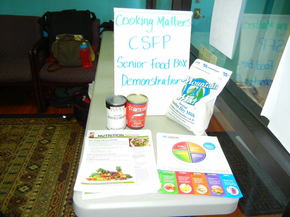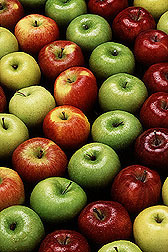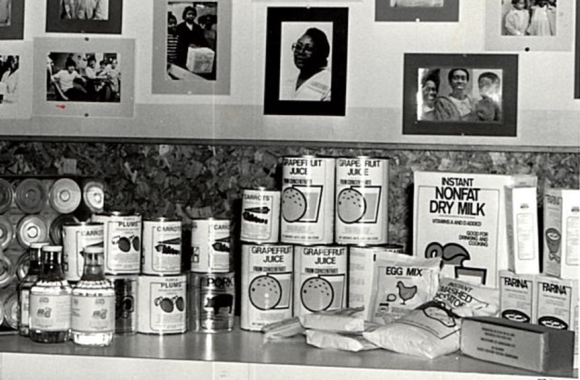
Hurricane season began June
1st. Were you ready?
Although disasters can happen any time of year, USDA recommends
reviewing disaster preparedness information at least once a year. What better
time than the beginning of hurricane season? You can start with the USDA
Foods Program Disaster Manual. This is a great basic resource to help
Federal, State and local partners understand when and how USDA Foods can be
used effectively in disaster response.
A new USDA Foods Disaster Preparedness online training is now
available from The Institute of Child Nutrition www.theicn.org
(formally known as NFSMI). This new course is free. You can earn one continuing
education unit after completing the course. Use the NFSMI
Quick Start Guide to register on the NFSMI website www.nfsmi.org.
|
Chef Develops
Healthy Menus and School Lunch Cookbook using USDA Team Nutrition Grant
The USDA blog featured a guest post from Chef Brenda Thompson, who developed recipes for Idaho's Chef Designed School Lunch Cookbook, a resource featured in our Creating Healthy Menus Using USDA Foods webinar! Read on to learn how she incorporated USDA Foods and tested recipes with students.
Chef Leverages USDA Team Nutrition Grant to Develop Healthy Menus for Students
By Chef Brenda Thompson, RDN
As an advocate for school foodservice staff, I am committed to being a resource—both in getting the word out about the nutrition goals schools are achieving daily and in helping kitchen staff be more efficient and have fun at their jobs.
In conjunction with these goals, I am often presented with opportunities to provide support for schools in meeting the standards set forth in the Healthy Hunger Free Kids Act of 2010. Since I enjoy marketing healthy foods to kids and encouraging them to try new things, these opportunities are a great privilege.
The Idaho State Department’s Child Nutrition Program (CNP) was provided a USDA Team Nutrition Grant and then chose me to develop the recipes for the Chef Designed School Lunch Cookbook.
This cookbook contains a two-week cycle lunch menu including 17 of my recipes which were designed and developed with school foodservice target budgets in mind. Each day’s menu utilizes between four and eight USDA Foods in order to keep costs low. Read more
Chef Brenda and food service staff prepare breakfast burrito recipe for school taste testing.
The
5th Annual USDA Southeast Regional Office/State Agency/Food Bank Conference
On May 21, 2015, USDA Food and Nutrition
Service’s Southeast Regional Office in partnership with The Atlanta Community Food Bank (ACFB) and
The Georgia
Food Bank Association hosted the 5th Annual Southeast Regional Food Bank Conference.
The day started off with a tour of the ACFB and their wonderful facilities. Bill
Bolling, ACFB Executive Director, provided opening remarks and framed the day. Robin
Bailey, Regional Administrator, provided the group with the USDA perspective and discussed how a number of our food
assistance programs are impacting individuals and households in the
Southeast. Keeping with tradition, Diane Kriviski, USDA Food and
Nutrition Service Deputy Administrator, provided
the group with program updates for a number of USDA food assistance programs.
Over
the past few years the topics at this meeting have grown to include discussions
around what roles food banks can and do play with a number of USDA programs
including The
Emergency Food Assistance Program, The Summer
Food Service Program, and the Supplemental
Nutrition Assistance Program. The meeting is a good opportunity for USDA,
State agencies and Food Banks to network together to discuss current trends and
talk about strategies for implementing and increasing participation in these
vital food assistance programs.
 Southeast Regional Administrator Robin Bailey giving opening remarks at the 5th Annual Southeast Regional Food Bank Conference.
Release
of FNS Instruction 709-5
USDA revised its Shipment
and Receipt of USDA Foods agreement on June 2, 2015. The
newly revised FNS Instruction 709-5, Rev 2, replaces the prior version, Rev. 1
dated April 1, 1993.
The purpose of this Instruction is to establish the general
standards and procedures that the State distributing agency (SDA), Indian
Tribal Organization (ITO) or other consignee must follow in receiving shipments
of USDA Foods (i.e., donated foods) in USDA food assistance programs, including
the Commodity Supplemental Food Program (CSFP); the Food Distribution Program
on Indian Reservations (FDPIR); The Emergency Food Assistance Program (TEFAP);
the National School Lunch Program (NSLP); the Nutrition Services Incentive
Program (NSIP), which is administered by the Department of Health and Human
Services; and in other outlets; and to convey established responsibilities for
other entities such as USDA Foods vendors and carriers.
The standards and procedures established in this Instruction are
necessary in determining if shipments of USDA Foods are received in optimal
condition and in the quantities ordered, and ensuring the proper disposition
and replacement of USDA Foods when circumstances warrant.
State or ITO questions may be referred to Regional Office staff.
 Alternative Value Pass-Through System Pilot
On
May 8, 2015, Food and Nutrition Services released a policy memo entitled, Alternative
Value Pass-Through System Pilot Project under the Department of Defense Fresh
(DoD Fresh) Program. This memo details a new method for crediting school
districts for the value of DoD Fresh food items. The purpose of this pilot is
to reduce reporting burden and simplify the crediting process. The new
method allows companies that provide prepared meals to schools to immediately
credit the school district for the value of the DoD Fresh food they receive.
This reduces the amount of work required to track the value of the food. Other
methods of crediting school districts involve added tracking and reporting
steps since the credit is not passed on to the school district until later in
the invoicing process.
We
hope that providing this alternative will encourage broader use of DoD fresh
food items in prepared meals. This will allow school districts to take fuller
advantage of their entitlement and reduce burden for smaller meal vending
companies.
|
ACDA Gives Back! Visit to Utah Food Bank
USDA
staff was on the ground recently to visit the Utah Food Bank and volunteer their time
to support its mission. This visit was
planned to close out the American Commodity Distribution Association (ACDA)
conference activities hosted in Salt Lake City in early May. The
Utah Food Bank provides services to food pantries and CSFP programs in Utah and
relies on USDA Foods to provide support for these programs.
ACDA
attendees, including USDA staff, stepped in to help the Food Bank sort and
repack totes of potatoes into boxes for distribution to partner programs around
the state. Attendees were also able to tour the facility to get a
behind-the-scenes look at the storage and distribution process to get USDA
Foods and donated food to 134 partner programs in Utah. The Utah Food
Bank has implemented a variety of innovative programs
and initiatives to improve services, but USDA staff was especially impressed
by the volunteer program in which children decorate the outside of the CSFP
boxes to help brighten the day of the program recipients. It is exciting
to see all of the unique strategies recipient agencies have to maximize food
resources and improve program services. We thank the Utah Food Bank for sharing
their best practices with us.
If
you have implemented programs or initiatives that you think others would like
to hear about in a future e-letter, please send them to us at USDAFoods@fns.usda.gov.
 (Left to right) USDA staff, Dana Rasmussen, Julie Skolmowski, and Christina Riley helped prepare boxes for distribution at ACDA.
 Have you ever wondered where your USDA Foods cheese and milk come from? Dairy products may originate with cows, sheep, and goats, but they would never make it to school lunches and households around the country without our partners at the USDA in Kansas City, Missouri. Meet Bill Lang, who supervises a procurement staff of 9 and contracts totaling over $225 million per year. Bill's team procures mozzarella cheese, including cheese sticks, primarily for schools; process cheese and cheddar cheese for all USDA Foods programs; evaporated and shelf-stable milk, primarily for household programs; and the new high-protein fat-free yogurt for schools. He is also in charge of the service contracts for the national distributors of household foods, with warehouses in Nampa, Idaho; Kansas City; and Syracuse, New York.
Bill has worked at USDA for 28 years, starting out in the finance area before transitioning to humanitarian food aid shipments, through which he had the opportunity to travel to Haiti, Kenya, Ethiopia, Yemen, and Bulgaria to carry out fact-finding trips in support of USDA-procured international humanitarian food aid. He joined dairy procurement in 2003 and enjoys facilitating communication with contractors and suppliers, ensuring customer service, developing and training his staff to help them grow in their careers, and engaging in problem-solving when challenges arise. Bill's goal is to ensure that USDA continues to be considered a best customer with suppliers in the dairy industry, so that interested parties will compete in the marketplace to supply commercially viable USDA Foods.
USDA has been working hard to meet the new school meal patterns and deliver products that can perform well in the cafeteria and in the oven. Bill said one of the biggest changes he has
witnessed in dairy procurement is the implementation of the meal pattern
requirements and resulting demand for more lower sodium and lower fat options. He also noted the positive trend towards portability of nutritious dairy products for school children, such as the 4 oz. cup of high protein yogurt and the 1 oz. cheese stick.
After completing his degree in Agricultural Business at the University of Missouri, Bill worked for a sanitation service company for food processing plants, performing inspections of cheese, milk, beef, pork, and poultry plants. He took a management opportunity with USDA that has evolved into a wonderful career path, reflecting the dual mission of supporting the American dairy industry and producers while also improving nutrition and food security. Bill has learned a lot about the impressive level of nutrition--from vitamins, minerals, and amino acids--in dairy products such as yogurt and cheese. Try one of these USDA Foods today!
|

The Idaho Food bank launches CSFP to help hungry seniors
The Idaho Food Bank is working to solve
senior hunger in Idaho with the addition of the Commodity Supplemental Food
Program (CSFP). Idaho is one of seven States added to the program late in 2014. Idaho’s launch took
place on Friday, May 8 at the Salvation Army location in Boise. It shed light
on the needs of hungry seniors in Idaho and partnership efforts to address that
hunger. Idaho’s strategy includes a multi-faceted approach involving food
distribution and nutrition education.
The
Food Bank has teamed up with the Idaho Commission on Aging to distribute
the CSFP food boxes. This program is designed to improve the health of people at
least 60 years of age by supplementing their diets with nutritious USDA Foods. The
Food Bank will distribute 2,000 boxes of food to Idaho seniors each
month once the program is fully operational. Those boxes will be distributed
statewide with designated partners in each region, including The Salvation Army
in Boise.
|
 (Top) Idaho Food Bank staff share recipes and MyPlate resources during a cooking demonstration that introduced participants to salmon cakes made with CSFP foods. (Bottom) Idaho Food Bank Program Director Jackie Yarbrough leads a tour of the Salvation Army Food Pantry in Boise. The Salvation Army is one of the first sites to offer CSFP benefits in Idaho.

FFAVORS to Require
Customer Entry of Goods Receipt
The Fresh
Fruits and Vegetable Order Receipt System (FFAVORS) will receive the final
phase for the removal of the automated goods receipt function with the next
software release. Scheduled for June 28th, this final
phase will enforce the rule that all orders must be receipted by the customer
within 7 calendar days of the requested delivery date. Simply stated, if
you have placed an order to be delivered on Tuesday, the customer has until
close of business the following Tuesday to enter the receipt. If this is
not performed, the customer will not have the ability to enter a new
order. To streamline the receipting steps in FFAVORS, the receipting
process was modified within the software release. Now, a receipt can be
performed with only 3 clicks of the mouse.
The goods
receipt entry is immediately applied so if a customer finds they are unable to
place their new order due to an outstanding goods receipt, the receipt can be
entered and will immediately open the ability to place new orders.
The receipting process is outlined in the user manual and the new steps will be
updated with the June 28th software release. The manual
can be access by selecting the ‘Help’ link found in the FFAVORS
application. As always, any questions can be sent your DLA account representative or the FFAVORS@FNS.USDA.GOV mailbox.
|
 CSFP has come a long way since 1980's when it supplied eligible women, infants and children. Some foods available when this photo was taken included: Infant Formula, Canned Meat, Canned Fruit and Vegetables, Fruit Juices, Instant Non-fat Dry Milk, Instant Farina, Instant Potatoes, Peanut Butter, Dried Egg Mix, Evaporated Milk, Light Corn Syrup and Processed Cheese. Today, CSFP has over 50 items on its Foods Available List and is now designed to meet the nutritional needs of Seniors.
Food Distribution staff will be participating in these upcoming national meetings in 2015. We look forward to these opportunities to meet you and hope to see you there!
July 12-15: School Nutrition Association (SNA) Annual National Conference in Salt Lake City
|